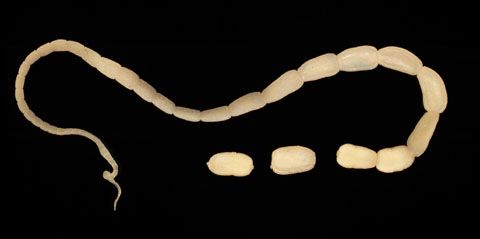Worms in Cats – Feline Friends
by e.g.d.mccarrison bvms mrcvs
vet of the year 2007
It can be distressing to be told that at some point in your cat’s life, it will almost certainly be affected by worms. however, this is an unfortunate fact of feline life; and it’s vital for your own health, as well as your cat’s, that you introduce regular deworming into your “cat grooming” regimen.
so what are worms?
There are about 8 different types of intestinal worms that can infect your cat, and some can be passed between cats and people. roundworms and tapeworms are the most common. both types spend their adult lives in the cat’s intestines, and in small amounts they are not very harmful. however, in large quantities they can cause suffering, illness and even death.
roundworms (toxocara cati and toxascaris leonine)
As the name suggests, roundworms look similar to garden worms, only much thinner. they are long, circular in cross section (not unlike spaghetti), and usually pointed at each end. their eggs are shed in the cat’s feces, but being microscopic there is often no evidence that they are present.
When they are born, many kittens will get these worms from the larvae in their mother’s milk.
mice, voles, shrews and birds can be infected with roundworm larvae, and when the cat catches the prey and eats it, the eggs hatch in the stomach.
In addition to regular deworming (which we’ll cover later), it’s important to clean litter boxes regularly because of the transfer of eggs in your cat’s fecal matter to their paws and fur, which are then swallowed as the cat burrows. groom it
tapeworms (such as dipylidium caninum and taenia taeniae formins)

Tapeworms are usually much larger than roundworms. they hook into the lining of the cat’s intestines and develop long, ribbon-like bodies, the ends of which become egg sacs that break open and exit through the rear duct. you will often see these segments in the cat’s feces or in the hair around the cat’s bottom. when dried, the egg sacs resemble grains of rice.
These particular worms are a much bigger problem in older cats, especially those who hunt or are regularly infected with fleas. the life cycle of a tapeworm involves a second intermediate “host”; and this is a flea or (as with roundworms) a small mammal like a mouse. the most common is the flea tapeworm (diplidium) which is acquired by the cat by swallowing fleas infected with the larvae of the tapeworm. just one such flea can infect your cat and therefore it is extremely important that your “cat care” regimen also includes regular and effective flea control.
symptoms
Symptoms of worm infestation are negligible in the early stages, so regular worm monitoring is essential. by the time symptoms appear, your cat’s health has already been damaged.
Symptoms of roundworms are primarily vomiting, diarrhea, weight loss, dull coat, and lack of energy. in severe cases, a swollen/distended tummy (tummy), which is particularly noticeable in kittens.
Many cats do not show any symptoms of tapeworms. the most common are increased hunger, dragging the bottom on the ground due to the irritation caused by the worm, and more time washing the anal area. as mentioned above, the appearance of egg-filled segments, which look like small grains of rice, around the cat’s bottom.
hookworms (ancylostoma tubaeforme) are blood-sucking parasites that live in the small intestine and are becoming an increasing threat, mainly due to the increasing population of foxes, many of which carry the infection . the eggs are deposited on the ground in the fecal matter of the foxes and there they hatch, being picked up by the cat’s paws. In addition to the same symptoms as roundworm, dark stools (caused by bleeding, which can lead to anemia) and diarrhea are also typical signs.
can worms infect humans?
Some types of worms can be spread between cats and people. For example, the eggs of some of the roundworms can be ingested accidentally, with the result that the egg can hatch and the larva then migrates out of the intestine and takes up residence in the tissues of our bodies. while this is not common, there are reports of some children eating the eggs and suffering eye damage and even blindness as a result. since the eggs are also left in the soil when an infected cat relieves itself, it is always recommended to wear gloves when working in the garden.
common tapeworms are much less likely to infect humans, however again this can occur and is more likely the result of ingesting an infected flea.
treatment and risk reduction
It’s important to understand that you can’t actually prevent worms; and that they are so frequent that the vast majority of our cats will be infected. however, with regular and effective worm control as an integral part of your “cat care” regimen, you can get rid of any worms that are present at the time of treatment, thus eliminating the threat of disease and suffering to cats. what we have. referred to above.
There are a multitude of different anti-parasitic products (for different types of worms) available on the market in pet stores, supermarkets and on the internet; and therefore it can be very difficult, and often confusing, to be sure that you are using the correct ones. some treatments are effective against roundworm and tapeworm, while others are only effective against one or the other.
Not only the range of products is huge, but also the ways to manage them. some excellent ones are still in tablet form. other effective ones come in the form of an anointing, or as pastes, powders, syrups or with injections by your vet. Since regular worm treatment is very important to your cat’s well-being, it’s a good idea to talk to your vet before deciding which ones are right for your particular cat.
In my experience, cats don’t like to be dewormed, and some are extremely difficult to treat with tablets, even palatable ones. for this reason, I personally believe that ‘spot-on’ treatments are by far the easiest to administer.
a good “spot” treatment can also control fleas at the same time, and although the tapeworm should be treated separately, the flea treatment itself will reduce the incidents of your cat ingesting the tapeworm eggs through A flea. Usually a combined flea and worm treatment is applied monthly, followed by a separate tapeworm treatment every two to three months.
Many good flea treatments also control roundworms and hookworms. This combination treatment is useful because it reduces incidents of your cat ingesting tapeworm eggs via a flea, as well as treating roundworms and hookworms. Treatments are usually applied monthly. however, if you use them, you will need to apply a separate tapeworm treatment every two to three months.
Bayer has a product called ‘profender’ which is a spot treatment for roundworms, hookworms and mature tapeworms, so this only leaves the fleas to be treated.
This can all seem a bit confusing, especially since some flea control products contain a drug similar to those that control worms, and both types should not be used on the same cat for fear of “overdosing” on similar drugs. . drugs this is another very good reason to take your vet’s advice.
In general practice, I have frequently seen cats whose owners, with the best of intentions, have used commercially available treatments but without success, either due to misuse, difficulty in administration, or lack of efficacy of the product itself. . as a result, the cats were not being dewormed effectively. For this reason, I reiterate my recommendation that you seek advice at your veterinary office.
additional risk reduction precautions include wearing gloves when gardening, making sure litter trays are sanitized regularly, and that your cat’s bedding is laundered as often as possible. if children play in a yard where cats have access, make sure youngsters always wash their hands afterwards.




